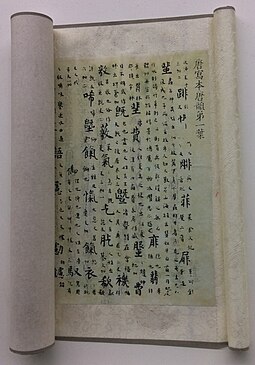Facts for Kids
Cantonese is a vibrant and colorful language belonging to the Yue Chinese family, spoken by over 80 million people, mainly in Guangdong and Hong Kong.
Overview
Linguistic Features
Cultural Significance
Dialects Of Cantonese
History And Development
Cantonese Cuisine Vocabulary
Global Cantonese Communities
Writing System And Romanization
Cantonese In Media And Entertainment
Learning Cantonese Resources And Methods

Inside this Article
Chinese Characters
San Francisco
Jackie Chan
Han Dynasty
Restaurant
Hong Kong
Guangzhou
Culture
English
Singing
Did you know?
🇨🇳 Cantonese is primarily spoken in Guangdong Province and Hong Kong, with over 80 million speakers!
🎶 The language uses six to nine tones, which means the same word can have different meanings based on how you say it.
🎉 Cantonese is the language of many traditional Chinese festivals, including Lunar New Year.
🎤 There are three main tones in Cantonese: high, mid, and low, which help change the meaning of words.
😄 You can sometimes drop the subject in Cantonese, like saying just 'Eat!' instead of 'I eat!'
🎈 Cantonese has a rich history that dates back over 2,000 years to the Han Dynasty.
🏙️ The language has borrowed words from English and French due to trade and colonization.
🗣️ There are around 50 dialects of Cantonese, making it diverse like the people who speak it.
🖋️ Cantonese uses traditional Chinese characters for writing, which are more complex than simplified characters.
🌟 Cantonese connects people to their heritage and is a treasure trove of culture, traditions, and delicious foods!
Introduction
For example, "ma" can mean "mother," "horse," or "to scold" just by changing how you say it! Isn’t that interesting? It’s also the language of many traditional Chinese festivals like Lunar New Year! 🎉
Linguistic Features
Tones change the meaning of words; just like how your voice changes when you’re happy or sad! There are three main tones: high, mid, and low. It also has special sounds that are not found in English, like "ng" at the beginning of words, as in "ngoh" (I). Languages often have unique sentences, and in Cantonese, sometimes you don’t need to say the subject! Instead of saying "I eat," you might just say "Eat!" How neat! 😄
Cultural Significance
Through Cantonese, people express stories, traditions, songs, and jokes! Food plays an essential role too! Yum! Famous dishes like dim sum and char siu (barbecue pork) are enjoyed by many around the world. 🥢
Festivals, like the Lantern Festival, are celebrated with specific customs and tongue twisters in Cantonese! Speaking Cantonese connects people to their heritage and helps them share their vibrant culture with others. What a beautiful way to unite! 💖
Dialects Of Cantonese
️ For example, in Guangzhou, people speak a slightly different version of Cantonese compared to Hong Kong! The differences can include pronunciation and some vocabulary choices. Some may use unique slang and expressions! 👾
In total, there are around 50 dialects under Cantonese, showing that the language is as diverse as the people who speak it! 🌍
History And Development
It grew when trade increased, making it the language of bustling markets and lively streets! Over time, Cantonese has borrowed words from other languages like English and French due to trade and colonization. 🏙
️ Hong Kong became a major city for Cantonese, making it popular worldwide! Today, people celebrate Cantonese’s history through music, art, and film, keeping the language alive and thriving! 🎶
Cantonese Cuisine Vocabulary
"Dim sum" means “small bites,” and "wonton" refers to dumplings filled with shrimp or pork. "Cha siu" is honey-glazed barbecue pork, delicious with rice! Don’t forget "pinyin," which means goods or items! 🥡
Learning these tasty words gives you a taste of Cantonese culture! Next time you visit a Chinese restaurant, impress your friends and family by ordering in Cantonese! It's yummy and educational! 😋
Global Cantonese Communities
Many Cantonese-speaking communities thrive worldwide! Major cities like San Francisco, New York, and Vancouver have large Cantonese populations. People celebrate their culture through community events, delicious food, and festivals! 🍜
Chinese New Year festivities bring families together to share traditions, family gatherings, and yummy treats! In schools, they may offer Cantonese classes to help younger generations stay connected to their roots. Isn’t it exciting how languages keep cultures alive? 🎉
Writing System And Romanization
People often use Chinese characters that show meaning, and there are over 50,000 characters in total! For everyday writing, Cantonese uses traditional characters, which look more complex compared to simplified characters used in Mandarin! 🖋
️ There’s also a special way to write Cantonese using Roman letters called "Romanization." One popular system is Jyutping! 🙌
It helps people who learn the sounds of Cantonese but can’t read Chinese characters yet. Isn’t that clever? 📚
Cantonese In Media And Entertainment
Hong Kong is known as a film hub where brilliant movies like "Kung Fu Hustle" and "Crouching Tiger, Hidden Dragon" are made! Action stars like Jackie Chan and Donnie Yen often use Cantonese in their films! 🎬
Cantonese pop music, or Canto-pop, is also popular across Asia! Singers like Eason Chan and Faye Wong fill our hearts with catchy tunes! 🎶
Many kids love watching cartoons and shows in Cantonese, making learning fun!
Learning Cantonese: Resources And Methods
You can start by listening to children’s songs in Cantonese or watch cartoons with subtitles. Singing along helps improve your speaking! Try language apps designed for kids, like Duolingo or HelloChinese! 📱
Another way to learn is through games and flashcards with family and friends! If you find a local school offering Cantonese classes, jumping in is a great way to practice! Let’s discover the beauty of Cantonese together—happy learning! 📚🥳

